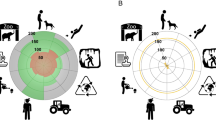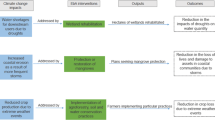Abstract
Setting species priorities is commonly based on the assessment of multiple conservation criteria, and point-scoring methods are broadly used for obtaining ranked species lists. However, the implications of different procedures in the performance and application of resulting lists have been scarcely investigated. In this study, we test the effect of using distinct transformation and summarization of criteria for computing ranked lists for species prioritization and allocation of seed collection resources. The study is focused on the Cantabrian Range (Spain), where 127 vascular plants of conservation concern were scored according to four criteria (threat, protection, endemicity and rarity) related to different geographical scales. Four conservation priority indices (CPI) were computed using a combination of (a) ordinal- versus quantile-weighted transformation and (b) mean versus factorial summarization. Quantile transformation and factorial summarization provided a more quantitative CPI. Although the contribution of criteria to the final indices was different under quantile and ordinal transformations, the four CPI were strongly correlated. However, slight differences between indices reflected divergences in the selection of species priorities when low conservation funds are available, and 14 to 32% of the species composition in priority groups changed. Our results suggest that different point-scoring procedures might have high impact on the application of priority lists for selecting conservation targets, especially when different funding scenarios are compared. We also recommend to (1) avoid ordinal scoring methods, (2) use unequally weighted transformations and (3) apply point-scoring methods based on multi-scale criteria for integrating existing lists in biogeographical areas



Similar content being viewed by others
References
Abellán P, Sánchez-Fernández D, Velasco J, Millán A (2005) Assessing conservation priorities for insects, status of water beetles in southeast Spain. Biol Conserv 121:79–90
Akçakaya R, Ferson S, Burgman MA, Keith DA, Mace GM, Todd CR (2000) Making consistent IUCN classifications under uncertainty. Conserv Biol 14(4):1001–1013
Anderson S (2002) Identifying important plant areas. Plantlife International, London
Atkins K (2005) Declared rare and priority flora list for Western Australia, 22 February 2005 Department of Conservation and Land Management. Como, WA
Avery M, Gibbons DW, Porter R, Tucker T, Williams G (1994) Revising the British Red Data List for birds, the biological basis of UK conservation priorities. Ibis 137(Suppl):232–239
Bacchetta G, Bueno A, Fenu G, Jiménez-Alfaro B, Mattana E, Piotto B, Virevaire M (eds) (2008) Conservación ex situ de plantas silvestres Principado de Asturias. La Caixa, Oviedo
Burgman MA, Keith DA, Walshe TV (1999) Uncertainty in comparative risk analysis for threatened Australian plant species. Risk Anal 19:585–598
Burgman MA, Breninger DR, Duncan BW, Ferson S (2001) Setting reliability bounds on habitat suitability indices. Ecol Appl 11:70–78
Carter MF, Hunter WC, Pashley DN, Rosenberg KV (2000) Setting conservation priorities for land birds in the United States, the partners in flight approach. Auk 117:541–548
CBD (2001) Convention on biological diversity. http://wwwbiodivorg. Accessed 10 Feb 2010
Coates JD, Atkins KA (2001) Priority setting and the conservation of Western Australia’s diverse and highly endemic flora. Biol Conserv 97:251–263
Cofré H, Marquet PA (1999) Conservation status, rarity, and geographic priorities for conservation of Chilean mammals, an assessment. Biol Conserv 88:53–68
Domínguez Lozano F, Moreno Saiz JC, Sainz Ollero H (2003) Rarity and threat relationships in the conservation planning of Iberian flora. Biodivers Conserv 129:1861–1882
Dunn EH, Hussell DJ, Welsh DA (1999) Priority-setting tool applied to Canada’s landbirds based on concern and responsibility for species. Conserv Biol 136:1404–1415
Eaton MA, Gregory RD, Noble DG, Robinson JA, Hughes J, Procter D, Brown F, Gibbons DW (2005) Regional IUCN red listing, the process as applied to birds in the United Kingdom. Conserv Biol 19(5):1557–1570
Farnsworth EJ, Klionsky S, Brumback WE, Havens K (2006) A set of simple decision matrices for prioritizing collection of rare plant species for ex situ conservation. Biol Conserv 128:1–12
Grammont PC, Cuarón AD (2006) An evaluation of threatened species categorization systems used on the American continent. Conserv Biol 20(1):14–27
Harris GM, Jenkins CN, Pimm SL (2005) Refining biodiversity conservation priorities. Conserv Biol 19:1957–1968
Hartley S, Kunin W (2003) Scale dependency of rarity, extinction risk, and conservation priority. Conserv Biol 176:1559–1570
Heath MF, Evans MI (2000) Important bird areas in Europe, priority sites for conservation. Series no 8. Birdlife International Cambridge, United Kingdom
Holsinguer KE, Gottlieb LD (1991) Conservation of rare and endangered plants, principles and prospects. In: Falk DA, Holsinguer KE (eds) Genetics and conservation of rare plants, 195–208. Oxford University Press, New York
IUCN (2001) IUCN red list categories and criteria, Version 31 IUCN Species Survival Commission IUCN, Gland, Switzerland and Cambridge, UK ii+30 pp
IUCN (2003) Guidelines for application of IUCN red list criteria at regional levels, Version 30 IUCN Species Survival Commission IUCN, Gland and Cambridge
Jiménez-Alfaro B (2009) Evaluación del conocimiento florístico de la Cordillera Cantábrica (España) a partir de bases de datos de biodiversidad. Pirineos 164:117–133
Joseph L, Maloney RF, Possingham HP (2009) Optimal allocation of resources among threatened species: a project prioritization protocol. Conserv Biol 23(2):328–338
Keller V, Bollmann K (2004) From red lists to species of conservation concern. Conserv Biol 186:1636–1643
Knapp SM, Russell RE, Swihart RK (2003) Setting priorities for conservation, the influence of uncertainty on species rankings of Indiana mammals. Biol Conserv 111:223–234
Kolberg H (2003) Targeting collecting for conservation. In: Smith D, Dickie JB, Linington SH, Pritchard HW, Probert RJ (eds), Seed conservation turning science into practice Royal Botanic Gardens, Kew, pp 209–217
Lunney D, Curtin A, Ayers D, Cogger HG, Dickman CR (1996) An ecological approach to identifying the endangered fauna of New South Wales. Conserv Biol 2:212–231
Mace GM, Collar NJ (2002) Priority-setting in species conservation. In: Norris K, Pai DJ (eds) Conserving bird biodiversity: general principles and their application. Cambridge University Press (Conservation Biology Series no7)
Mace GM, Lande R (1991) Assesing extinction threats, toward a reevaluation of IUCN threatened species categories. Conserv Biol 5:148–157
Mace GM, Possingam HP, Leader-Williams N (2007) Prioritizing choices in conservation. In: MacDonald D Service K (eds) Key topics in conservation biology. Blackwell Publishing, UK, pp 17–34
Major J (1988) Endemism, a botanical perspective. In: Myers AA, Giller PS (eds) Analytical biogeography an integrated approach to the study of animal and plant distributions. Chapman & Hall, London
Marsh H, Dennis A, Hines H, Kutt A, McDonald K, Weber E, Williams S, Winter J (2007) Optimizing allocation of management resources for wildlife. Conserv Biol 21(2):387–399
Martín JL, Cardoso P, Arechavaleta M et al (2010) Using taxonomically unbiased criteria to prioritize resource allocation for oceanic island species conservation. Biodivers Conserv 19:1659–1682
Master LL (1991) Assesing threats and setting priorities for conservation. Conserv Biol 5:559–563
Maxted N, Guarino L (2003) Plannig plant genetic conservation. In: Smith D, Dickie JB, Linington SH, Pritchard HW, Probert RJ (eds) Seed conservation: turning science into practice. Royal Botanic Gardens, Kew, pp 37–78
Mehlman DW, Rosenberg KV, Wells JV, Robertson B (2004) A comparison of North American avian conservation priority ranking systems. Biol Conserv 120:383–390
Millsap BA, Gore JA, Runde DE, Cerulean SI (1990) Setting priorities for the conservation of fish and wildlife species in Florida. Wildlife Monogr 111:1–57
Moreno JC (coord) (2008) 2008 Red list of Spanish vascular flora. Dirección General de Medio Natural y Política Forestal (Ministerio de Medio Ambiente, y Medio Rural y Marino, y Sociedad Española de Biología de la Conservación de Plantas), Madrid
Pärtel M, Kalamees R, Reier Ú, Tuvi E-L, Roosaluste E, Vellak A, Zobel M (2005) Grou** and prioritization of vascular plant species for conservation, combinig natural rarity and management need. Biol Conserv 123:271–278
Possingham HP, Andelman SJ, Burgman MA, Medellín RA, Master LL, Keith DA (2002) Limits to the use of threatened species lists. Trends Ecol Evol 1711:503–507
Rabinowitz D (1981) Seven forms of rarity. In: Synge H (ed) The biological aspects of rare plant conservation Sinauer Associates. Sunderland, Mass, pp 182–204
Regan TJ, Master LL, Hammerson GA (2004) Capturing expert knowledge for threatened species assessments, a case study using NatureServe conservation status ranks. Acta Oecol 26:95–107
Rizzi A (2007) A new method for ranking in statistical units selected contributions in data analysis and classification. Springer, Berlin, pp 599–607
Rodriguez JP, Rojas-Suarez F, Sharpe CJ (2004) Setting priorities for the conservation of Venezuela’s threatened birds. Oryx 38:373–382
Roekaerts M (2002) The biogeographical regions map of Europe Basic principles of its creation and overview of its development European Environmental Agency, Copenhagen
Schmeller DS, Gruber B, Budrys E, Framsted E, Lengyel S, Henle K (2008) National responsibilities in European species conservation: a methodological review. Conserv Biol 22(3):593–601
Shi H, Ashibindu Singh A, Kant S, Zhu Z, Waller E (2005) Integrating habitat status, human population pressure, and protection status into biodiversity conservation priority setting. Conserv Biol 194:1273–1285
Stein BA (2002) States of the union, ranking America’s biodiversity Arlington. NatureServe, Virginia
Todd CR, Burgman M (1998) Assessment of threat and conservation priorities under realistic levels of uncertainty and reliability. Conserv Biol 12:966–974
Volis S, Blecher M (2010) Quasi in situ: a bridge between ex situ and in situ conservation of plants. Biodivers Conserv DOI 10.1007/s10531-010-9849-2
Wilson KA, McBride MF, Bode M, Possingham HP (2006) Prioritizing global conservation efforts. Nature 440:337–340
Acknowledgments
We thank Rob Mars for language revision and José María Iriondo for helpful comments to earlier versions of the manuscript. This work was partially supported by the Principate of Asturias regional government to the Oviedo University (CN-04-222 and SV-05-Gijon-2) and the Seed Bank of the Atlantic Botanical Garden. BJA was grant by the European Social Fund through the Spanish Ministry of Science (PTA2007-0726-I).
Author information
Authors and Affiliations
Corresponding author
Rights and permissions
About this article
Cite this article
Jiménez-Alfaro, B., Colubi, A. & González-Rodríguez, G. A comparison of point-scoring procedures for species prioritization and allocation of seed collection resources in a mountain region. Biodivers Conserv 19, 3667–3684 (2010). https://doi.org/10.1007/s10531-010-9921-y
Received:
Accepted:
Published:
Issue Date:
DOI: https://doi.org/10.1007/s10531-010-9921-y




